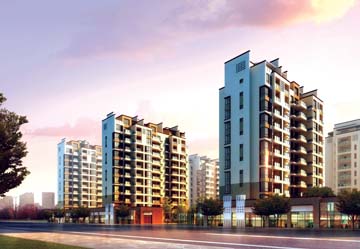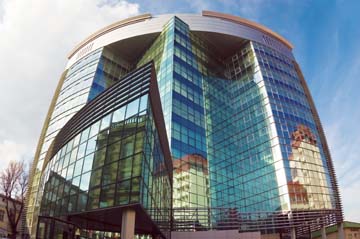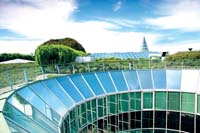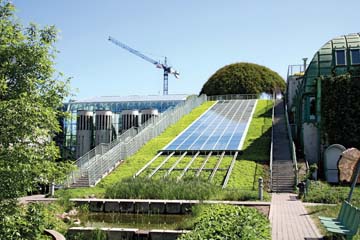Approach to Sustainability
|

|
| India is aware of the fact it happens to be the seventh largest emitter of global warming pollution, accounting for 4% of the world's emissions (1,866 million metric tonnes of carbon dioxide equivalent). As part of its effort towards mitigating the damage, India has pledged to reduce its emissions per unit of GDP to 20-25% below 2005 levels by 2020. |
Introduction
Imagine this... Ten years down the line, all major metropolitan cities in India turn out clean, green, and absolutely carbon free! Is this just another
'pie-in-the-sky' idea, or can it become a reality? It could very well become one, if the countrywide "go green" effort gains momentum. At present, a quiet, on-the-job, on-the-ground "greening" revolution is on, partnered by industry professionals, government agencies, environmentalists and thousands of concerned people across India. The "go green" movement is global today. Sharing the world's concern about the disastrous consequences of global warming, India too has in place a vigorous "go-green" program.
 |
India is aware of the fact it happens to be the seventh largest emitter of global warming pollution, accounting for 4% of the world's emissions (1,866 million metric tonnes of carbon dioxide equivalent). As part of its effort towards mitigating the damage, India has pledged to reduce its emissions per unit of GDP to 20-25% below 2005 levels by 2020.
Taking a cue from the developed world, the Indian construction industry has been taking large initiatives in this direction. A major effort is on by builders, developers, manufacturers and others in the field, in addition to government agencies to promote "green building" practices in all major cities. The "green building" concept incorporates several sustainable features, such as efficient use of water and energy, use of recycled/recyclable materials, effective use of landscape, best building management systems, all round waste management, and improved indoor air and temperature conditions to cut environmental contamination to the minimum. All of this calls for environment-friendly site planning, design, construction, operation and maintenance of buildings very much a part of the construction regime now.
 |
Support from industries, corporates and most institutions is considerable, with the "green" tag being much sought after from green offices, green hotels, green residences, and even green schools No wonder the "green building" market in India today is pegged to grow three-fold from $10 billion to $30 billion in the next four years. |
Advantages of Green Building
| Reduced energy consumption without sacrificing the comfort levels |
| • Conservation of Natural Resources |
| • Reduced air and water pollution |
| • Reduced water consumption |
| • Limited waste generation due to recycling and reuse |
| • Reduced pollution loads |
| • Increased user productivity |
| • Enhanced image and marketability |
| • Improved indoor air quality |
| • Reduction of construction waste |
| • Recycling possibility |
The Benchmark
The "green building" initiative came from the United Kingdom with the formation of the Building Research Establishment Environmental Assessment Method (BREEAM) in 1990. Today, trained assessors help in BREEAM-certifying 'green' buildings as Pass, Good, Very Good, and Excellent or Outstanding. The main criteria for getting a BREEAM rating are good building management, diminution in CO2 emissions from building operations and transport, location and access of staff members, efficient use of water, best use of building location, effective use of waste management, improved indoor environment quality, and use of responsibly resourced materials in constructing a building. Besides the UK, BREEAM operates in other countries like Netherlands, Spain, Norway and Sweden.
|

|
| India too launched a green building benchmarking institution the Indian Green Building Council (IGBC), in 2001 in Hyderabad as part of the Confederation of Indian Industry (CII) and the Sohrabji Godrej Green Business Centre in the city. |
The response to the Green movement has been tremendous globally, with a large number of certifying organisations coming up in various parts of the world thereafter. The United States formed the United States Green Building Council (USGBC) in 1993, which later developed the benchmark for Leadership in Energy and Efficient Design (LEED) for rating green buildings. The LEED certificate is applicable to all projects, including new constructions, existing buildings, commercial spaces, residential and others. The buildings are eligible for four levels of rating; Certification, Silver, Gold, and Platinum. The U.S. move was followed by Philippines forming the Philippines Green Building Council (PHILGBC) in 2002, New Zealand inducting Green Star NZ in 2005, and Singapore launching the Green Mark in 2005.
India too launched a green building benchmarking institution -- the Indian Green Building Council (IGBC), in 2001 in Hyderabad as part of the Confederation of Indian Industry (CII) and the Sohrabji Godrej Green Business Centre in the city. In fact, the CII-Sohrabji Godrej Green Business Centre building itself was conceived, designed and constructed as a green building. Based on the USGBC rating system, the centre became the first Platinum LEED certified building in India. Besides this centre, other green buildings which have obtained the Platinum rating include Hiranandani BG House and Crisil House buildings in Powai and Thane - Mumbai.
Green material and products
As the demand for environmental compliance grows, the focus is shifting towards manufacturing eco-friendly materials. While constructing a green building, it is very important to match the products and materials to the specific design and site to reduce the overall environmental impact. With the use of green materials, the building owner, and occupant can avail a plethora of benefits accrued by way of efficient use of water and energy, effective use of landscape, better management system and indoor conditions. The steady increase in demand for green buildings has brought down the cost of products, services and materials, thus making green buildings affordable. A classic example of the sharp decline in a product's cost is the waterless urinal. This eco-friendly urinal cost Rs. 20,000 per number when the CII-Godrej GBC building was constructed in 2001. Today it is available for Rs.6,000 per number.
Industry leaders opine that certain incentives from government, like raising the floor area ratio, speedy clearances etc. would not only encourage more developers and designers to adopt to green building certification, but also further bring down the cost of the eco-friendly material and fittings used.
The Immediate future
Less than a hundred years ago, industrial revolution came to India and changed many of the traditional sustainable practices in Indian buildings. The insatiable thirst for progress and comfort at any cost altered the equation with nature forever. Concrete, steel, glass and later plastics became the dominant construction materials, beyond stone and wood of yesteryears. Power supply, artificial lighting, water supply and disposal, and thermal environmental control within built environment, were desired and obtained.
Modern Indian Buildings
It is estimated that modern Indian buildings consume;
- About 25 to 30 percent of total energy.
- About 30 percent of fresh potable water.
- Generate about 40 percent of total waste.
- By 2050, the built foot print of India may become four times the current built mass.
Unless enough measures are taken, it may lead to acceleration of environment degradation, contributing to increased carbon footprint leading to global warming and climate change.
Studies also have shown that- Sustainable buildings demonstrate reduction in energy and water consumption to less than half of the present consumption in conventional buildings, and complete elimination of the construction and operational waste through recycling.
Indian construction industry will do better using our traditional wisdom and practices, building in harmony with nature through regional common knowledge, consuming as little as necessary, applying low cost technology innovations, using recycled materials, and recognizing performance (not intent) through easily measurable parameters wherever feasible.
Basic Design Considerations
Following are some of the basic considerations while designing a High Performance Building or a Green Building.
- Minimize resource consumption (Conserve)
- Maximize resource reuse (Reuse)
- Use renewable or recyclable resources (Renew/Recycle)
- Protect the natural environment (Protect nature)
- Create a healthy, non-toxic human environment (Non-Toxics)
- Apply Life Cycle Cost Analysis (Economics)
- Pursue Quality in creating the built environment (Quality)
Part 11 'Approach to Sustainability' NBC 2005
This Part 11 'Approach to Sustainability' provides a comprehensive set of requirements, intended to reduce the negative impact of buildings on the natural environment. It can be readily used by the owners, developers/builders, architects, engineers, building services engineers and other building professionals as well as by manufacturers of building materials apart from the Authorities concerning land and building development, government and private construction agencies and academic and research institutions. The intent of this Part is to highlight sustainability measures including those referred to in different Parts/Sections of the Code as may be required as well as to define comprehensive sustainability standards for the building construction and related built environment.
The approach to sustainability is founded on principles consistent with this Code, to adequately protect public health, safety and welfare and to provide requirements that do not unnecessarily increase construction cost nor restrict the use of new materials, products or methods of construction. The benefits of incorporating measures listed in this Part 11 are not only environment friendly, but also result in much better health and productivity of occupants, at minimal additional initial cost over the cost of conventional buildings, while substantially reducing the life cycle cost. This minimal additional cost is offset during a few years usage of the buildings, and vast advantage in cost is accrued during the life cycle of the building.
The Need for Sustainable Development
Building construction, occupancy and additions/alterations including preventive and curative maintenance are always energy centric. Large amount of elementary form of energy in the form of water, natural materials, air, etc are consumed for the purpose. While, these elements and their use are inter-dependent and there is need for integrated approach of considering them all together in general design development and construction practice, the approach towards utilizing them is independent of each other.
With increasing urbanization and rapid rise in people's economic level and consumption pattern in many parts of the country, there is an increasing trend to consume more natural resources per capita. This is evident from the aspirational lifestyles and resulting in changing tastes and expenditure patterns of individuals and societies. This is equally witnessed from modern construction trends and changing sky lines of cities. This is constantly putting tremendous pressure on fragile ecosystem by over exploitation of natural resources adversely affecting biodiversity of our planet. Realizing this fact, there are efforts for a changing approach towards nature initially from 'humanization of nature' to 'naturization of human' and more recently towards sustainable development. The concept is to ensure that every living being on earth will have equal opportunity to utilize the natural and manmade resource for survival and to develop for mutual benefits for all time to come. The inclusive aspect of development will come into sharp focus while deciding on choices.
 |
To achieve this, it is important to accept major challenge in controlling and judiciously using natural resources to shrink ecological foot print, famously known as carbon foot print, a measure to understand our consumption patterns. The way to achieve this is by holistically planning our growth needs, one of which is construction and combining them with need based economy, but at the same time without compromising on functionality and essential comforts.
The basic components of building facility, their inter-correlation, tradeoffs and effect on surrounding micro-climatic conditions have to be understood, to achieve the harmony between buildings and ecological surroundings. It is necessary to assess the association of various factors involved, rationalizing the impacts of construction on neighbourhoods or building micro-climatic conditions for sustainability of built environment.1
The proposed draft provides a comprehensive guidelines to reduce the negative impact of buildings on the natural environment, sustainability standards for built environment and can be readily used by all the concerned.
Highlights of the Draft
The Proposed draft on Sustainability starts by defining related terminologies and goes on to explain the approach to Sustainability very systematically and in detail.
- Every building material has embodied energy and understanding of this parameter is very important.
- The approach from concept to completion and the disposal of constructed materials at the end of designed life of a building.
- Emphasis on building Envelope Systems.
- Use of locally available materials and resources
- Integrated water management
- Operational maintenance and services.
- Disaster Preparedness- Natural and Manmade
- Disaster Risk assessment and Mitigation.
- Siting, Thermal Massing, Orientation, Ventilation,
- Reduced Footprints, Life Cycle Assessment etc.
- Landscaping, Rain water harvesting, Ground water recharging etc
- Urban transportation, Bicycle lanes etc.
- Green Roofing systems
- Solar Penetration, infiltration, UV Considerations,
- Window Glazing etc.
- Eco Friendly building Materials
- Water and Waste water management, HVAC
- Sustainable Construction Practices.
- Heritage Buildings and New Constructions
Implementation
 |
Provisions for building planning, design including material selection and structural design, construction, operation and maintenance have been covered in National Building Code of India: Part 0 to Part 10. These also allow various options to be exercised, for example while various building materials have been listed therein along with their quality requirements for compliance, the choice may rest with the owner/ building professionals, say for walling or masonry units, the options could be: use of common burnt clay bricks, perforated clay bricks, hollow clay bricks, fly ash lime bricks, fly ash clay bricks, calcium silicate bricks, solid/hollow concrete blocks, light weight concrete blocks, autoclaved aerated concrete blocks, preformed foam concrete blocks or any other alternative specified. This Part 11 discusses such options from sustainability point of view for guiding in their appropriate selection. Similar explanation applies to other materials as also other aspects in planning, design, construction, operation and maintenance. However, once a choice of material, design methodology, construction technique/methodology, operation and maintenance related options, etc, is made, the provisions given in this Part for the same shall be complied with. This Part 11 also prescribes provisions to be necessarily complied with so as to help achieve the objective of sustainability.1
References
1. NBC 2005- Proposal